1.1 What is the Blockchain?
Stop overpaying - start transferring money with Ogvio. Sign up, invite friends & grab Rewards now! 🎁
You’ve probably seen those flashy headlines that blockchain technology is considered by many to be a revolutionary innovation, and one that can change the world in many different ways, that blockchain is the FUTURE, and so on and so forth. Even though it receives extensive mainstream news hype seemingly every single day, most people still aren’t completely sure what blockchains are, and how they actually could use them.
In this section, I’ll be explaining to you - what is a blockchain, how blockchains work, how are they different from traditional technology, and how YOU could use them, too.
Ready? Let’s get to it!

Video Explainer
Video Explainer: What is the Blockchain?
Reading is not your thing? Watch the "What is the Blockchain?" video explainer
What is Blockchain? (Animated Examples + Explanation)


What is a Blockchain?
The term actually consists of two words - a “block”, and a “chain”. A “block” is a place where we store data and various types of information. In the same manner, as you would store your butter and milk in a fridge to keep them cool, data is stored in blocks in order to keep it safe, structured, and easily accessible.
What about a “chain”? Each block has information about the block previous to it, and this forms the connection, or a “chain”, between each block standing nearby, like in a physical chain.
Now, what sort of information is stored in these blocks? Well, while you can store different types of data in these virtual chests, blocks usually hold just simple strings of textual data - we call them “transactional records”.
Why “transactional” records? Simply because Bitcoin, the most popular cryptocurrency that you’ve probably already heard about, was one of the highly adopted uses of blockchain in the masses, and it turned out to become a substitute for the daily currencies we’re used to live with.
So, Bitcoin is a currency. And every trade of a currency should have an action, and normally, in your daily life, you call it a “transaction”.
Obviously, the same way we have it in the real world, on the blockchain they’re called the same as when trading Bitcoin - transactions! Thus, all records of actions on the blockchain are called transactions, even if those actions are not related to any sort of cryptocurrencies or digital money anymore.
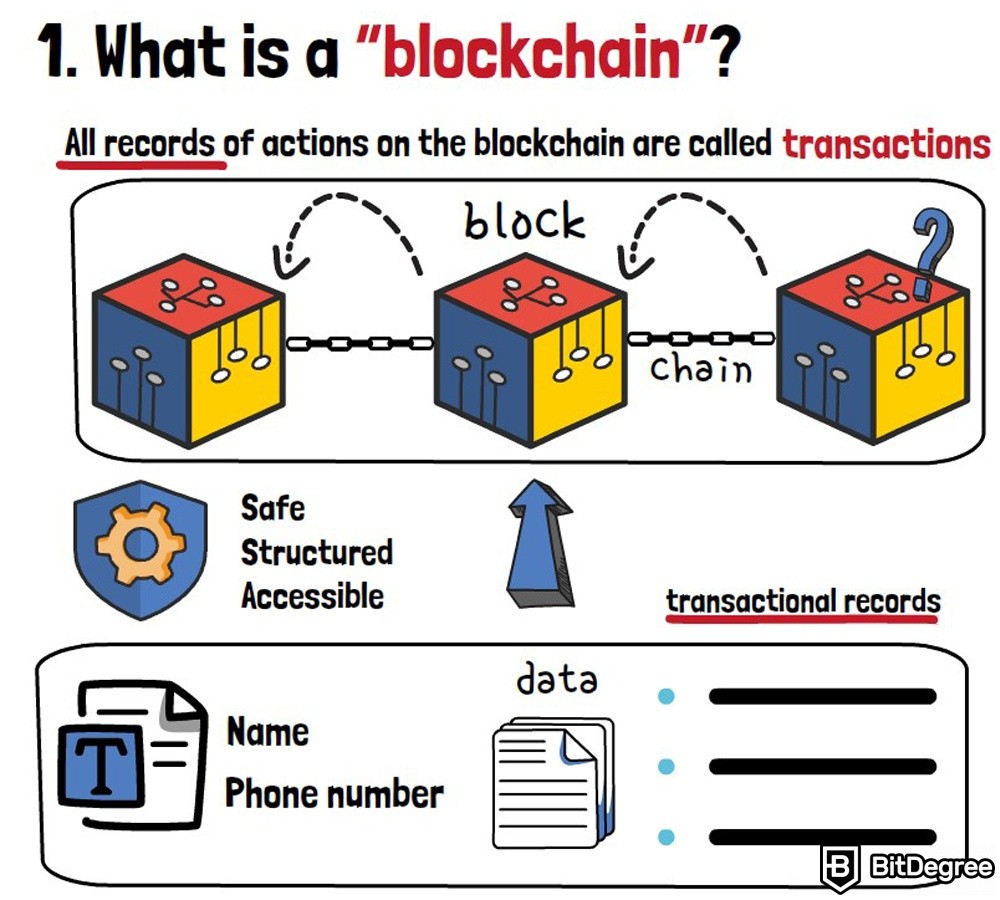
For example, it can be just a textual log record of something that we want to store on a blockchain, let’s say, your name or a phone number, and yes, we still call it a transaction record, because of the historic matter I just told you about.
Sounds cool, but what does that look like? Well, a typical transaction on a blockchain would look a little something like this:
“Sam paid Joe $20”
Simple enough, right? Well, a single block can store hundreds or even thousands of transactions! The capacity depends on the individual blockchains, but newer ones can usually store many more transactions than their older iterations.
So where is the “chain” part here? As I explained to you before, the “chain” refers to the fact that all blocks of information are connected with each other, chronologically.
A very simple way to look at it would be like this:
Imagine that, in our earlier example, Sam paid Joe $20 last Friday. In the next few days, Joe paid Elly $50, and Elly paid Tom $10. All of these transactions happened in that order, and thus, it’s important for them to be tracked in that order, as well! Blocks of information can contain the data, but them being connected by virtual chains helps to track when each transaction happened, and how they are all connected, too.

Now, I can hear you asking - why can’t we just create a single block, and store all of the information on it? Well, for the same reason we can’t take a single bus to drive all of the people from one city to another - it doesn’t have enough space and speed to drive them all at once!
Blocks are very limited in how many transactions they can hold. On top of that, multiple blocks allow for transactions to be registered on them much faster since they don’t have to be packed in one, single digital area.
Think about it - you go to the shop for groceries, gather everything you need, and start making your way towards the checkout. It’s a busy day - there are a lot of other shoppers trying to checkout, as well. Now, imagine that there was a Black Friday or a Christmas sale happening - millions of people came to participate and grab discounts offered by this small business.
This would result in you likely spending hours or even days in the shop, just trying to make your way through all of the people! Now, if there were multiple shops like that, and people would have to wait in a queue to enter, this would be much more orderly.
So, to recap, a blockchain is simply a place where data (or information) is stored in a very effective manner. This information could refer to many different things, but for the sake of keeping the learning curve simple, let’s just say that the main type of data stored on blockchains is transaction records.
How Does a Blockchain Work?
Well, the first thing that you need to know here is that, in order for blockchains to store data, this data needs to be inputted into the blocks. In other words, this requires work to be done! If you want to get to the shop that’s a few miles away, you could either go on foot, drive your car there, or catch a bus - simply put, there are a few different ways you could get there.
Applying that same logic to our topic at hand, there are a few different methods of how work can be performed on the blockchain, in order for it to store data. The two major methods are called “Proof-of-Work” and “Proof-of-Stake” - I’ll keep it simple today, and only talk about these two.
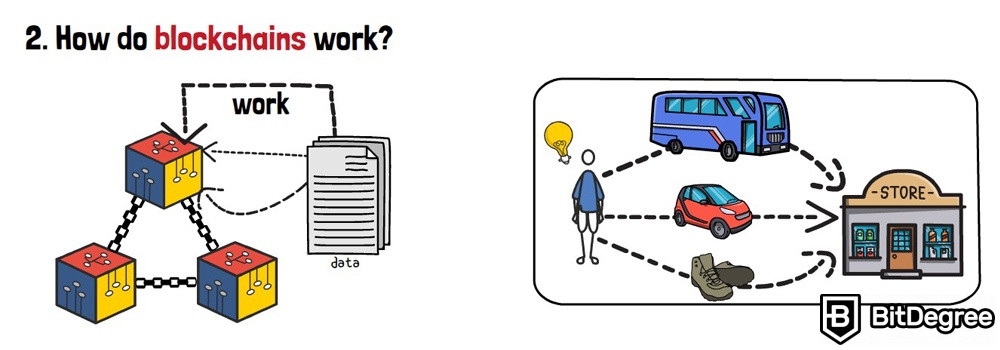
So, the most popular method is called “Proof-of-Work”! Normally, once transactions are agreed upon between the users, they need to be approved, before they are saved to a block in the chain.
So, besides you and the public blockchain itself, we involve an extra element - The Miner - a computer, or actually, a mass of computers called nodes, that work to solve complex mathematical queries to confirm those aforementioned transactions, and, let’s say, - to save your records in a blockchain. Those nodes are decision-makers, a consensus who check and agree to store your transaction.
Now, let’s not get too technical - instead, allow me to go back to simple examples!
In the real world, miners mine rocks in order to find precious ores, such as iron and gold. Mining is their work, and the reward is the product that they mine. To be completely frank with you, the same process happens with mining on the blockchain, as well!
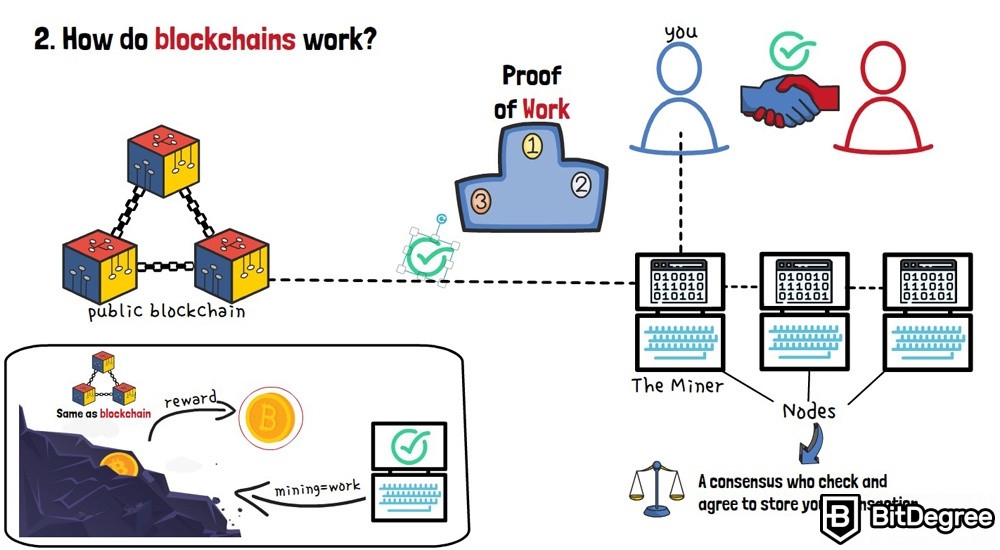
Because it’s a virtual transaction, instead of a person mining, you have a computer doing the job. Instead of precious ores, these computer machines get rewards in cryptocurrency that they mine. They do the work for others - confirm the transactions happening on the network - and get rewarded for doing so.
Before we continue, I can imagine that you’re wondering - who are these miners that confirm transactions on the blockchain?
Well, in order to answer that question, you first need to know what “decentralization” is.
Decentralization in Crypto
Most blockchains are decentralized. This simply means that they do not belong to a single authority - no company, CEO, or director owns the blockchain. In other words, there is no single, central figure governing it!
So… Who’s responsible for how the blockchain functions, then?
If you said “miners”, you are very correct!
To answer the original question - anyone can be a miner on the blockchain! In many cases, all that you need to do is connect your computer to the network, and dedicate its resources to the process of mining. This way, many people from all over the world can become miners, help manage the blockchain and confirm the transactions happening within.
Doing so, these miners will be rewarded with the cryptocurrency of the blockchain they mine - so, if you were to mine Bitcoin, you would receive BTC rewards!
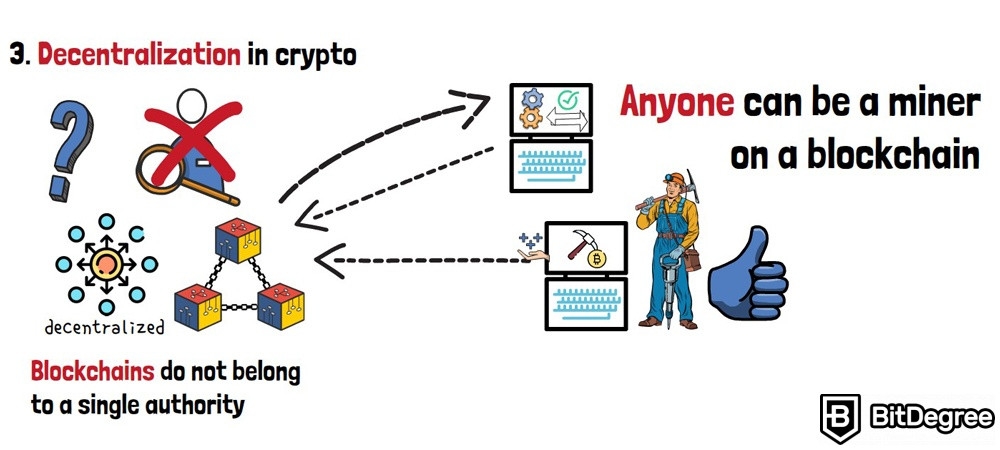
On the topic of how blockchains work, there is one thing that needs to be discussed - foul play, and how blockchains avoid it.
The essential question here is simple - how can blockchains make sure that none of the miners are malicious scammers, and that they won’t simply input a false transaction and run away with peoples’ funds?
Now, the question is simple, but it’s not that easy to answer without getting a bit technical. However, I won’t bore you with all of the technical detail and will just give you enough information so that you could understand the general premise around it.
All transactions happening on the blockchain are encrypted. This means that, say, when Sam pays Elly $73, this payment is anonymous on the blockchain, and is displayed in a sequence of numbers and letters.
Following that, remember the “chain” part in “blockchain”? And how it helps to keep the information (or transaction data) chronological? Well, in essence, due to the encryption and security features behind blockchains, all past-confirmed transactions cannot be changed.

Imagine that you’re about to present a poem in front of a class of students. The teacher will grade you for the way that you present that poem. Let’s say, you were quite successful with your presentation, and received a B - the teacher announced your grade to the entire class of students.
Now, if you or any other student would then go and claim that you’ve actually received an A+, no one would believe you - this is because there was an entire class of students who heard your actual grade announced! On a very fundamental level, this is how blockchains ensure that the transactions happening on them are truthful and legitimate.
Instead of a poem, you perform a transaction - send or receive digital money, in the form of cryptocurrency. Instead of a grade, you receive the data (confirmation) of your transaction. And instead of the class of students hearing your grade announced, there are miners who confirm the transaction.
Very cool, indeed!
So, then - up to this point, we’ve figured out that blockchains are virtual chests that store transaction data, and that they are able to encrypt these transactions so that no one could access and tamper with them. We’ve also covered the topics of decentralization and miners, too!
How Can You Use Blockchains in Your Life?
Currently, the most common way of how an average person uses blockchain technology is by purchasing and transacting with crypto. If you buy Bitcoin, and then send it to your friends, you ARE using blockchain tech to do so, whether you know it or not!
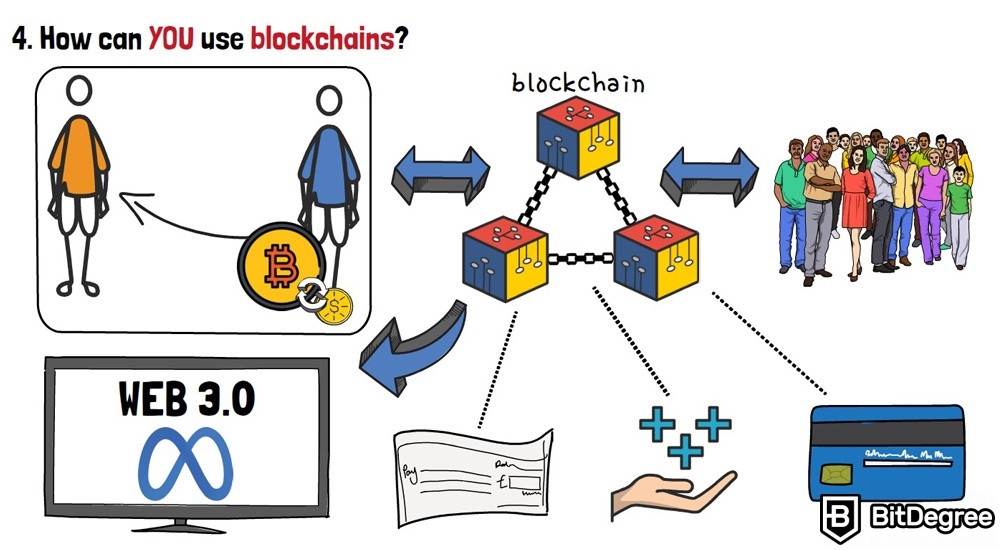
It is expected that, with time, blockchains will become more and more integrated into our daily lives. Traditional payment methods will be performed with the help of blockchain technology, loans will be given out on blockchains, and other financial operations will involve them, too.
Furthermore, blockchain technology is what powers concepts such as Web 3.0 and the Metaverse. I won’t go into detail on these topics here, since we’ve covered a lot already - if you’re interested to learn more, you can check the sections "What is Web 3.0?" and "What is the Metaverse?".










